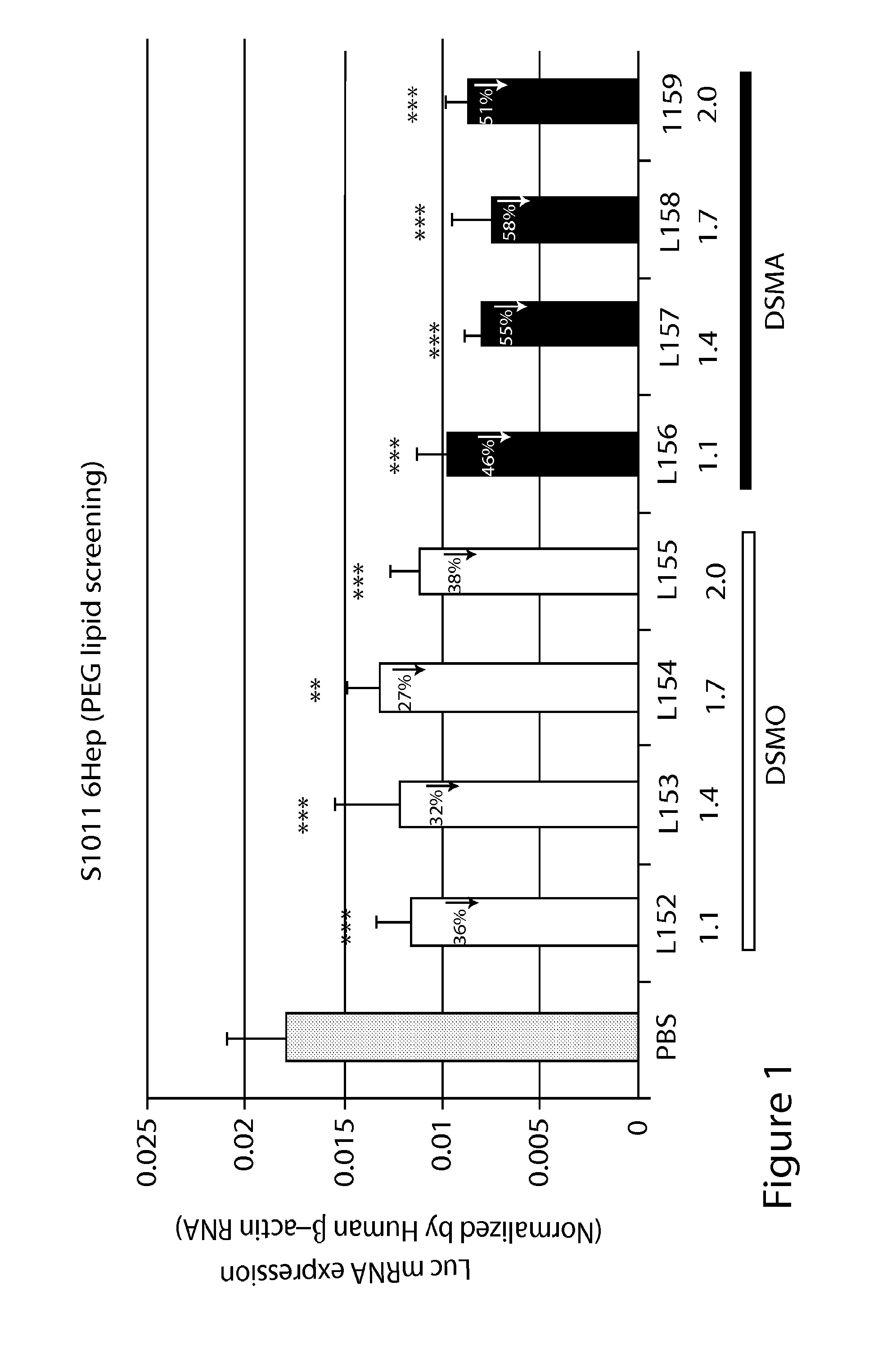Di-aliphatic substituted pegylated lipids
a technology of di-aliphatic and lipid, applied in the direction of ester active ingredients, amide active ingredients, drug compositions, etc., can solve the problems of reducing the activity of the construct, reducing the ability to gain access to the intracellular compartment, and susceptibility to nuclease digestion in plasma
- Summary
- Abstract
- Description
- Claims
- Application Information
AI Technical Summary
Benefits of technology
Problems solved by technology
Method used
Image
Examples
example 1
Synthesis of PEG-C-DSMO (8)
[0417]PEG-C-DSMO (8) may be prepared according to the synthetic scheme outline below.
Step 1: Synthesis of methanesulfonic acid octadeca-9,12-dienyl ester (2)
[0418]To a solution of the alcohol 1 (26.6 g, 100 mmol) in dichloromethane (100 mL), triethylamine (13.13 g, 130 mmol) was added and this solution was cooled in an ice-bath. To this cold solution, a solution of mesyl chloride (12.6 g, 110 mmol) in dichloromethane (60 mL) was added dropwise and after the completion of the addition, the reaction mixture was allowed to warm to ambient temperature and stirred overnight. The TLC of the reaction mixture showed the completion of the reaction. The reaction mixture was diluted with dichloromethane (200 mL), washed with water (200 mL), satd. NaHCO3 (200 mL), brine (100 mL) and dried (NaSO4). The organic layer was concentrated to get the crude product which was purified by column chromatography (silica gel) using 0-10% Et2O in hexanes. The pure product fractions ...
example 2
Synthesis of PEG-C-DMSA (13)
[0426]PEG-C-DMSA (13) may be prepared according to the synthetic scheme outline below.
Step 1: Synthesis of (9)
[0427]To a solution of (5) (50 g, 95 mmol) in DCM (400 ml) under argon atmosphere, was added TEA (53 mL, 378 mmol) and DMAP (1.2 g, 9.5 mmol) and stirred at room temperature. Reaction mass was cooled to −5° C. and a solution of mesyl chloride (15 mL, 190 mmol) in DCM (100 mL) was added slowly at temperature below −5° C. and allowed to warm to RT after addition. After 30 minutes (TLC), reaction mass was quenched with ice cold water (20 ml). Organic layer was separated, washed with 1N HCl (30 ml), water, brine, dried over sodium sulfate and evaporated at reduced pressure to obtain pure product (55 g, 95.5%) as yellow liquid. 1H NMR (400 MHz, CDCl3): δ 0.89 (t, 6H, J=6.8), 1.2-1.5 (m, 36H), 1.67 (m, 4H), 2.05 (q, 8H, J1=6.8, J2=6.8), 2.77 (t, 4H, J=6.4), 2.99 (s, 3H), 4.71 (m, 1H) and 5.36 (m, 8H).
Step 2: Synthesis of (10)
[0428]To a solution of (9) (...
example 3
Synthesis of PEG-S-DMSO (16)
[0434]
Synthesis of Compound 15
[0435]PEG-COOH 14 (5.00 g, 2.5 mmol) and DiLin-OH 5 were taken in DCM and treated with EDC (0.718 g, 1.5 eq), DMAP (100 mg, 0.819 mmol) and DIEA (0.869 mL, 2 eq). The resulting mixture was stirred at ambient temperature overnight and diluted with DCM. The organic layer was washed with water (2×100 mL) and dried over sodium sulfate. The crude product was purified by chromatography. First it was eluted with 10% EtOAC / DCM then 100% EtOAc to remove unreacted lipids. This was followed by 2-15% MeOH / DCM to afford the product (3.36 g, 53%) as a white solid. 1H NMR (400 MHz, CDCl3) δ 7.27 (d, J=9.8 Hz, 1H), 6.20 (t, J=5.1 Hz, 1H), 5.43-5.19 (m, 9H), 4.83 (p, J=6.0 Hz, 1H), 3.85-3.72 (m, 2H), 3.71-3.48 (m, 255H), 3.46-3.39 (m, 4H), 3.36 (d, J=0.7 Hz, 4H), 2.75 (t, J=6.3 Hz, 5H), 2.62 (t, J=7.1 Hz, 3H), 2.45 (t, J=7.1 Hz, 2H), 2.02 (q, J=6.4 Hz, 10H), 1.45 (t, J=16.2 Hz, 5H), 1.31 (ddd, J=23.6, 14.9, 10.1 Hz, 46H), 0.87 (t, J=6.7 Hz, 6...
PUM
| Property | Measurement | Unit |
|---|---|---|
| Fraction | aaaaa | aaaaa |
| Fraction | aaaaa | aaaaa |
| Fraction | aaaaa | aaaaa |
Abstract
Description
Claims
Application Information
 Login to View More
Login to View More - R&D
- Intellectual Property
- Life Sciences
- Materials
- Tech Scout
- Unparalleled Data Quality
- Higher Quality Content
- 60% Fewer Hallucinations
Browse by: Latest US Patents, China's latest patents, Technical Efficacy Thesaurus, Application Domain, Technology Topic, Popular Technical Reports.
© 2025 PatSnap. All rights reserved.Legal|Privacy policy|Modern Slavery Act Transparency Statement|Sitemap|About US| Contact US: help@patsnap.com



